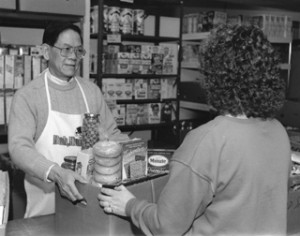The Food Shelf was Neighbors’ first program designed to help those in need in the south metro area. Neighbors’ Food Shelf opened its doors in 1972, and still continues to provide for the community forty years later. The Food Shelf provides food and hygiene products for about 330 families and individuals needing assistance each month.
Volunteers are the backbone of the operation, and without them, the Food Shelf would not be able to run. Neighbors’ has a very small staff; most of the work done is by volunteers. For instance, today in the food shelf there were four or five volunteers compared to one part-time staff person.
The Food Shelf operates mostly with the help of donations from individuals, businesses, and organizations. Some items are also purchased or obtained in bulk from retailers and from food banks. Food banks operate differently than food shelves in that they do not distribute the food directly to those in need. Instead, organizations such as Neighbors obtain food from the banks and distribute it to the community. The food bank Neighbors works closely with is Second Harvest Heartland who serves 59 counties in Minnesota and Western Wisconsin and is a member of Feeding America.
The needs of the Food Shelf are always changing, but donations are always welcomed and needed. The current needs of the Food shelf are posted just inside the lower level door, at the entrance to the office, and in the donation intake area, and they are updated weekly. At the time of this writing (5/30) the current needs are: canned meats, chili, stew, applesauce, pancake mix/syrup, jelly, toilet paper, toothpaste and deodorant.
Facts and Statistics (Provided by Second Harvest Heartland):
- 1 meal=1.28 pounds of food
- For estimated conversions use the following stats:
$5=18 meals; $10=37 meals; $50=180 meals; $100 feeds a family of four for one month - Demand for emergency food has doubled in Minnesota since 2005; today, 1 in 10 Minnesotans are at risk for missing meals. (Hunger in America Study)
- 1 in 8 Minnesota children lives at risk of hunger.
- 40% of the members of households served by Second Harvest Heartland are children under 18 years old.
- Since 2008, visits by seniors to suburban emergency food programs have increased by more than 70%.
- Only 23% of people age 60 and older who are eligible for the Federal Supplemental Nutrition Assistance Program — called Food Support in Minnesota — actually receive benefits.

